Towards Transferable Use of Terrain Ruggedness Component in the Geodiversity Index
Abstract
1. Introduction
- To calculate if there are any differences in the results when calculating R with the same differences between the maximum and minimum values per block at different altitudes;
- To compare the values of R in two different microregional study areas within one region;
- To propose a possible standardized way of incorporating the ruggedness component into geodiversity evaluation at different levels.
2. Study Areas
3. Materials and Methods
3.1. Calculations of the Ruggedness Index at Different Altitudes
3.2. Form and Size of the Blocks
3.3. Calculating Terrain Ruggedness Index
3.4. Mapping Geodiversity Elements
3.5. Calculating Georichness
4. Results
4.1. Terrain Ruggedness Index at Different Altitudes
4.2. Terrain Ruggedness Index of Different Study Areas within Specific Regions
4.3. Terrain Ruggedness Classes as Geodiversity Elements
5. Discussion
6. Conclusions
Funding
Institutional Review Board Statement
Informed Consent Statement
Data Availability Statement
Acknowledgments
Conflicts of Interest
References
- Nieto, L.M. Geodiversidad: Propuesta de una definición integradora. Boletín Geológico Min. 2001, 112, 3–12. [Google Scholar]
- Gray, M. Geodiversity: Valuing and Conserving Abiotic Nature; John Wiley & Sons Ltd.: Chichester, UK, 2004; ISBN 1118525094. [Google Scholar]
- Serrano, E.; Ruiz-Flaño, P. Geodiversity: A theoretical and applied concept. Geogr. Helv. 2007, 62, 140–147. [Google Scholar] [CrossRef]
- Zwoliński, Z.; Najwer, A.; Giardino, M. Methods for Assessing Geodiversity. In Geoheritage; Reynard, E., Brilha, J., Eds.; Elsevier: Amsterdam, The Netherlands, 2018; pp. 27–52. [Google Scholar] [CrossRef]
- Panizza, M. The geomorphodiversity of the Dolomites (Italy): A Key of geoheritage assessment. Geoheritage 2009, 1, 33–42. [Google Scholar] [CrossRef]
- Bradbury, J. A keyed classification of natural geodiversity for land management and nature conservation purposes. Proc. Geol. Assoc. 2014, 125, 329–349. [Google Scholar] [CrossRef]
- Benito-Calvo, A.; Pérez-González, A.; Magri, O.; Meza, P. Assessing regional geodiversity: The Iberian Peninsula. Earth Surf. Process. Landforms 2009, 34, 1433–1445. [Google Scholar] [CrossRef]
- Argyriou, A.V.; Sarris, A.; Teeuw, R.M. Using geoinformatics and geomorphometrics to quantify the geodiversity of Crete, Greece. Int. J. Appl. Earth Obs. Geoinf. 2016, 51, 47–59. [Google Scholar] [CrossRef]
- Zakharovskyi, V.; Németh, K. Quantitative-qualitative method for quick assessment of geodiversity. Land 2021, 10, 946. [Google Scholar] [CrossRef]
- Hjort, J.; Luoto, M. Geodiversity of high-latitude landscapes in northern Finland. Geomorphology 2010, 115, 109–116. [Google Scholar] [CrossRef]
- Pellitero, R.; González-Amuchastegui, M.J.; Ruiz-Flaño, P.; Serrano, E. Geodiversity and Geomorphosite Assessment Applied to a Natural Protected Area: The Ebro and Rudron Gorges Natural Park (Spain). Geoheritage 2011, 3, 163–174. [Google Scholar] [CrossRef]
- Melelli, L. Geodiversity: A New Quantitative Index for Natural Protected Areas Enhancement. Geoj. Tour. Geosites 2014, 13, 27–37. [Google Scholar]
- Kot, R. The point bonitation method for evaluating geodiversity: A guide with examples (Polish Lowland). Geogr. Ann. Ser. A Phys. Geogr. 2015, 97, 375–393. [Google Scholar] [CrossRef]
- Melelli, L.; Vergari, F.; Liucci, L.; Del Monte, M. Geomorphodiversity index: Quantifying the diversity of landforms and physical landscape. Sci. Total Environ. 2017, 584–585, 701–714. [Google Scholar] [CrossRef] [PubMed]
- de Paula Silva, J.; Rodrigues, C.; Pereira, D.I. Mapping and Analysis of Geodiversity Indices in the Xingu River Basin, Amazonia, Brazil. Geoheritage 2015, 7, 337–350. [Google Scholar] [CrossRef]
- Crisp, J.R.A.; Ellison, J.C.; Fischer, A. Current trends and future directions in quantitative geodiversity assessment. Prog. Phys. Geogr. 2021, 45, 514–540. [Google Scholar] [CrossRef]
- Stepišnik, U.; Trenchovska, A. A New Quantitative Model for Comprehensive Geodiversity Evaluation: The Škocjan Caves Regional Park, Slovenia. Geoheritage 2018, 10, 39–48. [Google Scholar] [CrossRef]
- Pellitero, R.; Manosso, F.C.; Serrano, E. Mid- and Large-Scale Geodiversity Calculation in Fuentes Carrionas (NW Spain) and Serra do Cadeado (Paraná, Brazil): Methodology and Application for Land Management. Geogr. Ann. Ser. A Phys. Geogr. 2015, 97, 219–235. [Google Scholar] [CrossRef]
- Kaskela, A.M.; Kotilainen, A.T. Seabed geodiversity in a glaciated shelf area, the Baltic Sea. Geomorphology 2017, 295, 419–435. [Google Scholar] [CrossRef]
- Bétard, F.; Peulvast, J.P. Geodiversity Hotspots: Concept, Method and Cartographic Application for Geoconservation Purposes at a Regional Scale. Environ. Manag. 2019, 63, 822–834. [Google Scholar] [CrossRef]
- Perotti, L.; Carraro, G.; Giardino, M.; De Luca, D.A.; Lasagna, M. Geodiversity Evaluation and Water Resources in the Sesia Val Grande UNESCO Geopark (Italy). Water 2019, 11, 2102. [Google Scholar] [CrossRef]
- Pereira, D.I.; Pereira, P.; Brilha, J.; Santos, L. Geodiversity assessment of Paraná State (Brazil): An innovative approach. Environ. Manag. 2013, 52, 541–552. [Google Scholar] [CrossRef]
- Trenchovska, A.; Stojilković, B. Geodiverziteta Narodnega parka Severni Velebit. In Dinarski kras: Severni Velebit; Stepišnik, U., Ed.; Znanstvena založba Filozofske fakultete Univerze v Ljubljani: Ljubljana, Slovenia, 2019; pp. 108–124. [Google Scholar] [CrossRef]
- Stepišnik, U.; Ilc Klun, M.; Repe, B. Vrednotenje izobraževalnega potenciala geodiverzitete na primeru Cerkniškega polja. Dela 2017, 2017, 5–21. [Google Scholar] [CrossRef][Green Version]
- de Sena, Í.S.; de Ruchkys, Ú.A.; Travassos, L.E.P. Geotourism Potential in Karst Geosystems: An example from the Lund Warming Ramsar Site, Minas Gerais, Brazil. Catena 2022, 208, 1–10. [Google Scholar] [CrossRef]
- Kot, R.; Leśniak, K. Impact of different roughness coefficients applied to relief diversity evaluation: Chełmno Lakeland (Polish Lowland). Geogr. Ann. Ser. A Phys. Geogr. 2017, 99, 102–114. [Google Scholar] [CrossRef]
- Năpăruş-Aljančič, M.; Pătru-Stupariu, I.; Stupariu, M.S. Multiscale wavelet-based analysis to detect hidden geodiversity. Prog. Phys. Geogr. 2017, 41, 601–619. [Google Scholar] [CrossRef]
- Olsen, A.C.; Severson, J.P.; Allred, B.W.; Jones, M.O.; Maestas, J.D.; Naugle, D.E.; Yates, K.H.; Hagen, C.A. Reversing Tree Encroachment Increases Usable Space for Sage-Grouse during the Breeding Season. Wildl. Soc. Bull. 2021, 45, 488–497. [Google Scholar] [CrossRef]
- Riley, S.J.; DeGloria, S.D.; Elliot, R. A Terrain Ruggedness Index that Qauntifies Topographic Heterogeneity. Intermt. J. Sci. 1999, 5, 23–27. [Google Scholar]
- Xiong, Y.; Li, Y.; Xiong, S.; Wu, G.; Deng, O. Multi-scale spatial correlation between vegetation index and terrain attributes in a small watershed of the upper Minjiang River. Ecol. Indic. 2021, 126, 107610. [Google Scholar] [CrossRef]
- Zhang, Z.; Wang, L.; Liao, J.; Zhao, J.; Zhou, Z.; Liu, X. Dynamic stability of bio-inspired biped robots for lateral jumping in rugged terrain. Appl. Math. Model. 2021, 97, 113–137. [Google Scholar] [CrossRef]
- El Hasnaoui, Y.; Mhammdi, N.; Bajolle, L.; Nourelbait, M.; Bouimetarhan, I.; Cheddadi, R. Locating North African microrefugia for mountain tree species from landscape ruggedness and fossil records. J. African Earth Sci. 2020, 172, 103996. [Google Scholar] [CrossRef]
- Shetty, S.; Umesh, P.; Shetty, A. Dependability of rainfall to topography and micro-climate: An observation using geographically weighted regression. Theor. Appl. Climatol. 2022, 147, 217–237. [Google Scholar] [CrossRef]
- Martinez-Graña, A.M.; Goy, J.L.; Cimarra, C. 2D to 3D geologic mapping transformation using virtual globes and flight simulators and their applications in the analysis of geodiversity in natural areas. Environ. Earth Sci. 2015, 73, 8023–8034. [Google Scholar] [CrossRef]
- Ilić, M.; Stojković, S.; Rundić, L.; Ćalić, J.; Sandić, D. Application of the geodiversity index for the assessment of geodiversity in urban areas: An example of the Belgrade city area, Serbia. Geol. Croat. 2016, 69, 325–336. [Google Scholar] [CrossRef]
- Manosso, F.C.; de Nóbrega, M.T. Calculation of Geodiversity from Landscape Units of the Cadeado Range Region in Paraná, Brazil. Geoheritage 2016, 8, 189–199. [Google Scholar] [CrossRef]
- Duro, D.C.; Coops, N.C.; Wulder, M.A.; Han, T. Development of a large area biodiversity monitoring system driven by remote sensing. Prog. Phys. Geogr. Earth Environ. 2007, 31, 235–260. [Google Scholar] [CrossRef]
- Diao, Y.; Wang, J.; Yang, F.; Wu, W.; Zhou, J.; Wu, R. Identifying optimized on-the-ground priority areas for species conservation in a global biodiversity hotspot. J. Environ. Manage. 2021, 290, 112630. [Google Scholar] [CrossRef] [PubMed]
- Laidlaw, M.J.; Butler, D.W. Potential Habitat Modelling Methodology for Queensland, 2nd ed.; Queensland Herbarium, Department of Environment and Science: Brisbane, Australia, 2021. [Google Scholar]
- Uribe, S.V.; García, N.; Estades, C.F. Effect of Land Use History on Biodiversity of Pine Plantations. Front. Ecol. Evol. 2021, 9, 1–15. [Google Scholar] [CrossRef]
- Stojilković, B. Metodološki problemi vrednotenja geodiverzitete: Primer Krajinskega parka Logarska dolina. Dela 2019, 51–72. [Google Scholar] [CrossRef][Green Version]
- Serrano, E.; Ruiz-Flaño, P.; Arroyo, P. Geodiversity assessment in a rural landscape: Tiermes-Caracena area (Soria, Spain). Mem. Descr. Cart. Geol. d’It. 2009, LXXXVII, 173–179. [Google Scholar]
- Jačková, K.; Romportl, D. The Relationship Between Geodiversity and Habitat Richness in Šumava National Park and Křivoklátsko PLA (Czech Republic): A Quantitative Analysis Approach. J. Landsc. Ecol. 2012, 1, 23–38. [Google Scholar] [CrossRef]
- Beggs, P.J. New Directions: Climatediversity: A new paradigm for climate science. Atmos. Environ. 2013, 68, 112–113. [Google Scholar] [CrossRef]
- Wilson, J.P. Digital terrain modeling. Geomorphology 2012, 137, 107–121. [Google Scholar] [CrossRef]
- Burel, F.; Baudry, J.; Butet, A.; Clergeau, P.; Delettre, Y.; Le Coeur, D.; Dubs, F.; Morvan, N.; Paillat, G.; Petit, S.; et al. Comparative biodiversity along a gradient of agricultural landscapes. Acta Oecologica 1998, 19, 47–60. [Google Scholar] [CrossRef]
- Core Standardized Methods for Rapid Biological Field Assessment; Larsen, T.H., Ed.; Conservation International: Arlington, TX, USA, 2016; ISBN 978-11934151-96-9. [Google Scholar]
- Ransome, E.; Geller, J.B.; Timmers, M.; Leray, M.; Mahardini, A.; Sembiring, A.; Collins, A.G.; Meyer, C.P. The importance of standardization for biodiversity comparisons: A case study using autonomous reef monitoring structures (ARMS) and metabarcoding to measure cryptic diversity on Mo’orea coral reefs, French Polynesia. PLoS ONE 2017, 12, e0175066. [Google Scholar] [CrossRef] [PubMed]
- Junk, W.J.; Brown, M.; Campbell, I.C.; Finlayson, M.; Gopal, B.; Ramberg, L.; Warner, B.G. The comparative biodiversity of seven globally important wetlands: A synthesis. Aquat. Sci. 2006, 68, 400–414. [Google Scholar] [CrossRef]
- Stepišnik, U.; Repe, B. Identifikacija vročih točk geodiverzitete na primeru krajinskega parka Rakov Škocjan. Dela 2015, 2015, 45–62. [Google Scholar] [CrossRef]
- Brilha, J.; Gray, M.; Pereira, D.I.; Pereira, P. Geodiversity: An integrative review as a contribution to the sustainable management of the whole of nature. Environ. Sci. Policy 2018, 86, 19–28. [Google Scholar] [CrossRef]
- Araujo, A.M.; Pereira, D.Í. A New Methodological Contribution for the Geodiversity Assessment: Applicability to Ceará State (Brazil). Geoheritage 2017, 10, 591–605. [Google Scholar] [CrossRef]
- Zwoliński, Z. Spatial scales of geodiversity and taxonomic hierarchy levels of landforms. In Proceedings of the 20th EGU General Assembly, EGU2018; EGU: Vienna, Austria, 2018; p. 10778. [Google Scholar]
- Manosso, F.C.; Zwoliński, Z.; Najwer, A.; Basso, B.T.; Santos, D.S.; Pagliarini, M.V. Spatial pattern of geodiversity assessment in the Marrecas River drainage basin, Paraná, Brazil. Ecol. Indic. 2021, 126, 107703. [Google Scholar] [CrossRef]
- Ibáñez, J.-J.; Brevik, E.C. Divergence in natural diversity studies: The need to standardize methods and goals. Catena 2019, 182, 104110. [Google Scholar] [CrossRef]
- Ibáñez, J.J.; Brevik, E.C.; Cerdà, A. Geodiversity and geoheritage: Detecting scientific and geographic biases and gaps through a bibliometric study. Sci. Total Environ. 2019, 659, 1032–1044. [Google Scholar] [CrossRef]
- Pavlopoulos, K.; Evelpidou, N.; Vassilopoulos, A. Mapping Geomorphological Environments; Springer: Berlin/Heidelberg, Germany, 2009; ISBN 978-3-642-01949-4. [Google Scholar] [CrossRef]
- Stojilković, B. The traces of the last pleistocene glacial maximum in the eastern Kamnik-Savinja Alps. Dela 2017, 2017, 127–141. [Google Scholar] [CrossRef][Green Version]
- Stojilković, B.; Stepišnik, U.; Žebre, M. Pleistocenska poledenitev v Logarski dolini. Dela 2013, 40, 25–38. [Google Scholar] [CrossRef]
- ARSO Register Naravnih Vrednot (Območja). Available online: http://gis.arso.gov.si/geoportal/catalog/search/resource/details.page?uuid=%7BD007700F-CE87-4003-8CFA-81B22D11A8A5%7D (accessed on 2 February 2022).
- Ferrando, A.; Faccini, F.; Paliaga, G.; Coratza, P. A quantitative gis and ahp based analysis for geodiversity assessment and mapping. Sustainability 2021, 13, 10376. [Google Scholar] [CrossRef]
- Gold, C. Tessellations in GIS: Part I—putting it all together. Geo-Spatial Inf. Sci. 2016, 19, 9–25. [Google Scholar] [CrossRef][Green Version]
- Stefanovski, S.; Grk, J.; Hočevar, G. Kvantitativni model vrednotenja geodiverzitete na podlagi raznolikosti in gostote elementov geodiverzitete na primeru kontaktnega krasa med Kočevsko Reko ter Kostelom. Dela 2021, 75–103. [Google Scholar] [CrossRef]
- Mlekuž Vrhovnik, D. Modeliranje Pokrajine; Ciglič, R., Geršič, M., Perko, D., Zorn, M., Eds.; Založba ZRC: Ljubljana, Slovenia, 2020; pp. 123–131. ISBN 9789610504696. [Google Scholar] [CrossRef]
- Chrobak, A.; Novotný, J.; Struś, P. Geodiversity Assessment as a First Step in Designating Areas of Geotourism Potential. Case Study: Western Carpathians. Front. Earth Sci. 2021, 9, 1–20. [Google Scholar] [CrossRef]
- Rappaport, T. The Cellular Concept—System Design Fundamentals. In Wireless Communications: Principles and Practice; Pearson: London, UK, 2002; pp. 57–104. ISBN 0130422320. [Google Scholar]
- Nhancale, B.A.; Smith, R.J. The influence of planning unit characteristics on the efficiency and spatial pattern of systematic conservation planning assessments. Biodivers. Conserv. 2011, 20, 1821–1835. [Google Scholar] [CrossRef]
- ARSO Digital Elevation Model—LiDAR. Available online: http://gis.arso.gov.si/evode/profile.aspx?id=atlas_voda_Lidar@Arso&culture=en-US (accessed on 2 February 2022).
- Jenks, G.F. The Data Model Concept in Statistical Mapping. Int. Yearb. Cartogr. 1967, 7, 186–190. [Google Scholar]
- GURS. Surveying and Mapping Authority of the Republic of Slovenia (GURS); National topographic map 1:50,000; GURS: Ljubljana, Slovenia, 2010. [Google Scholar]
- Speleological Association of Slovenia (JZS) Cadaster of Caves. Available online: http://kataster.jamarska-zveza.si/ (accessed on 2 February 2022).
- Tukiainen, H.; Alahuhta, J.; Field, R.; Ala-Hulkko, T.; Lampinen, R.; Hjort, J. Spatial relationship between biodiversity and geodiversity across a gradient of land-use intensity in high-latitude landscapes. Landsc. Ecol. 2017, 32, 1049–1063. [Google Scholar] [CrossRef]
- Stojilković, B. Applying Evenness Measures to Geodiversity and Geomorphodiversity Evaluation. In Proceedings of the Building Connections for Global Geoconservation. In 10th International ProGEO online Symposium; Lozano, G., Luengo, J., Cabrera, A., Juana,, V., Eds.; Instituto Geológico y Minero de España: Madrid, Spain, 2021. [Google Scholar]
- Gray, M. Geodiversity: Developing the paradigm. Proc. Geol. Assoc. 2008, 119, 287–298. [Google Scholar] [CrossRef]
- Celarc, B. Geološka zgradba severovzhodnega dela Kamniško-Savinjskih Alp. Ph.D. Thesis, Univerza v Ljubljani, Ljubljana, Slovenia, 2004. [Google Scholar]
- Prelovšek, M. The Dynamics of the Present-Day Speleogenetic Processes in the Strem Caves of Slovenia; 2012; ISBN 9789612544058. Available online: https://omp.zrc-sazu.si/zalozba/catalog/book/949 (accessed on 2 February 2022).
- Cañadas, S.; Flaño, E.R. Geodiversity: Concept, Assessment and Territorial Aplication. Boletín De La Asoc. De Geógrafos Españoles 2007, 389–394. [Google Scholar]
- Gordon, J.E.; Barron, H.F. Valuing Geodiversity and Geoconservation: Developing a More Strategic Ecosystem Approach. Scottish Geogr. J. 2012, 128, 278–297. [Google Scholar] [CrossRef]
- Lombardo, V.; Piana, F.; Fioraso, G.; Irace, A.; Mimmo, D.; Mosca, P.; Tallone, S.; Barale, L.; Morelli, M.; Giardino, M. The classification scheme of the piemonte geological map and the OntoGeonous initiative. Rend. Online Soc. Geol. Ital. 2016, 39, 117–120. [Google Scholar] [CrossRef]
- Kubalíková, L.; Kirchner, K.; Bajer, A. Secondary Geodiversity and its Potential for Urban Geotourism: A Case Study from Brno City, Czech Republic. Quaest. Geogr. 2017, 36, 63–73. [Google Scholar] [CrossRef]
- Kubalíková, L. Assessing geotourism resources on a local level: A case study from Southern Moravia (Czech Republic). Resources 2019, 8, 150. [Google Scholar] [CrossRef]
- Skibiński, J.; Kultys, K.; Baran-Zgłobicka, B.; Zgłobicki, W. Geoparks in SE Poland as areas of tourism development: Current state and future prospects. Resources 2021, 10, 113. [Google Scholar] [CrossRef]
- Sanz, J.; Zamalloa, T.; Maguregi, G.; Fernandez, L.; Echevarria, I. Educational Potential Assessment of Geodiversity Sites: A Proposal and a Case Study in the Basque Country (Spain). Geoheritage 2020, 12, 13. [Google Scholar] [CrossRef]
- Lukic, D.; Andjelkovic, S.; Dedjanski, V. Geodiversity and geoheritage in Geography teaching for the purpose of improving students’ competencies in education for sustainable development. Forum Geogr. 2016, 15, 210–217. [Google Scholar] [CrossRef]


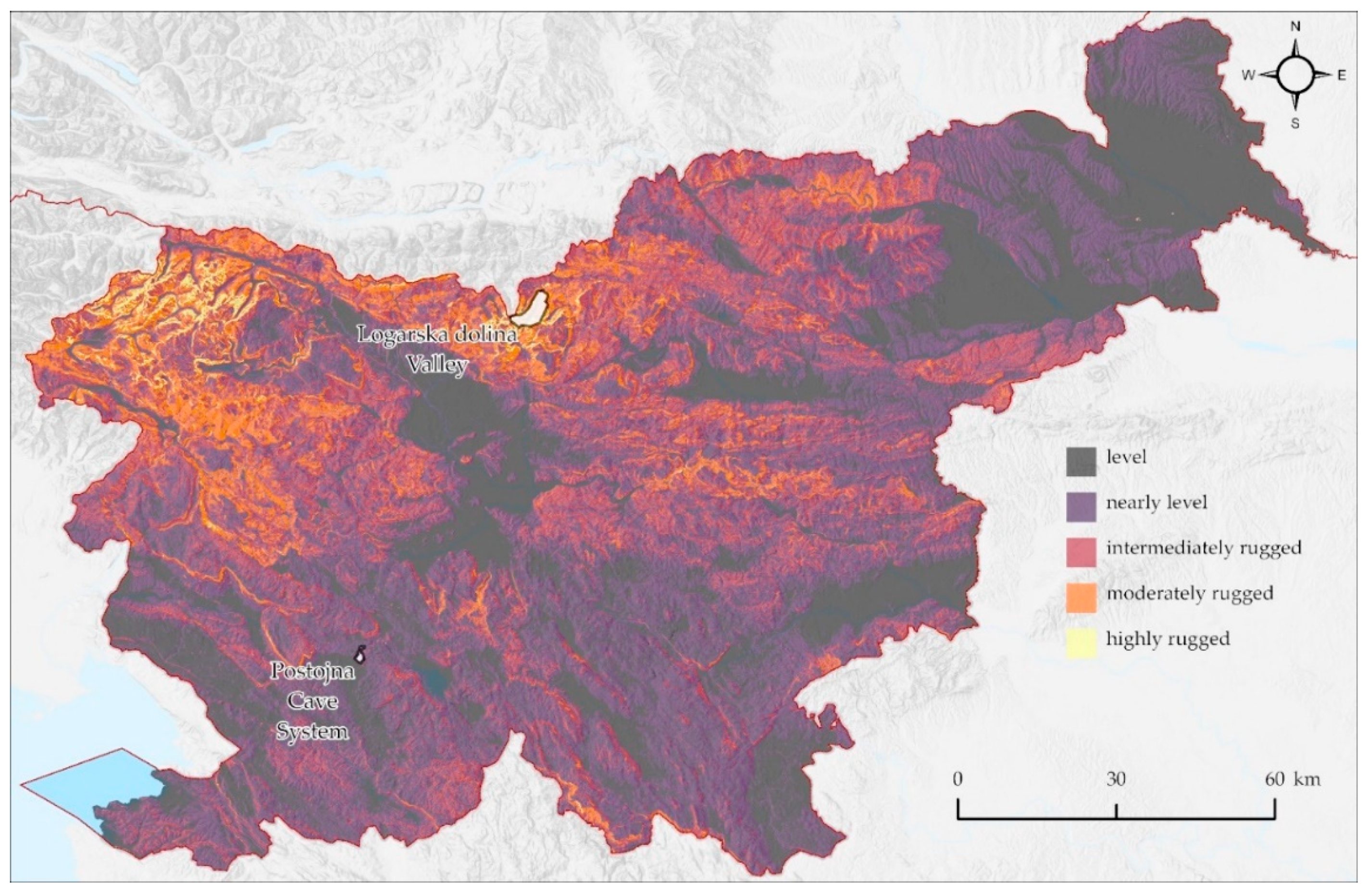
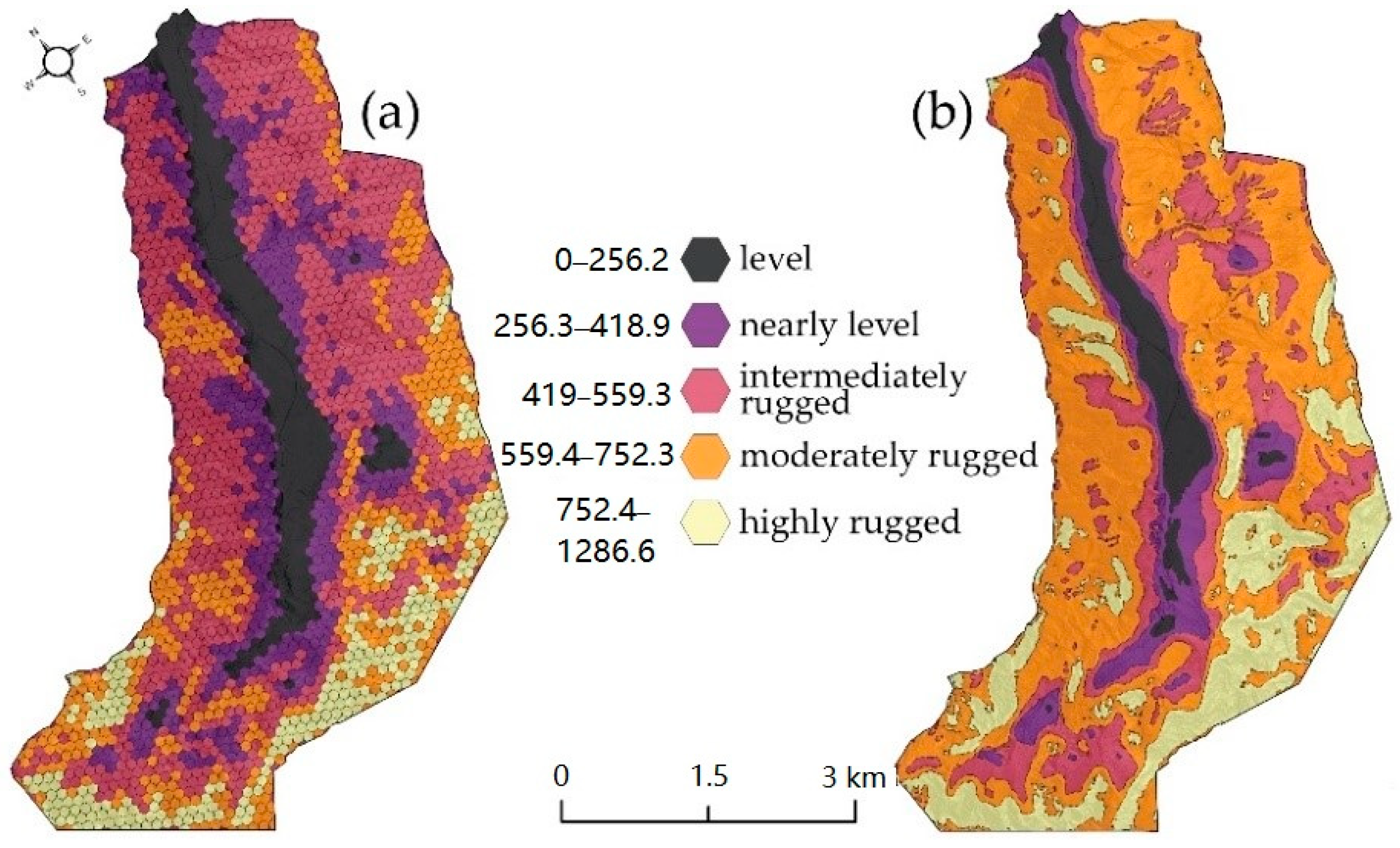
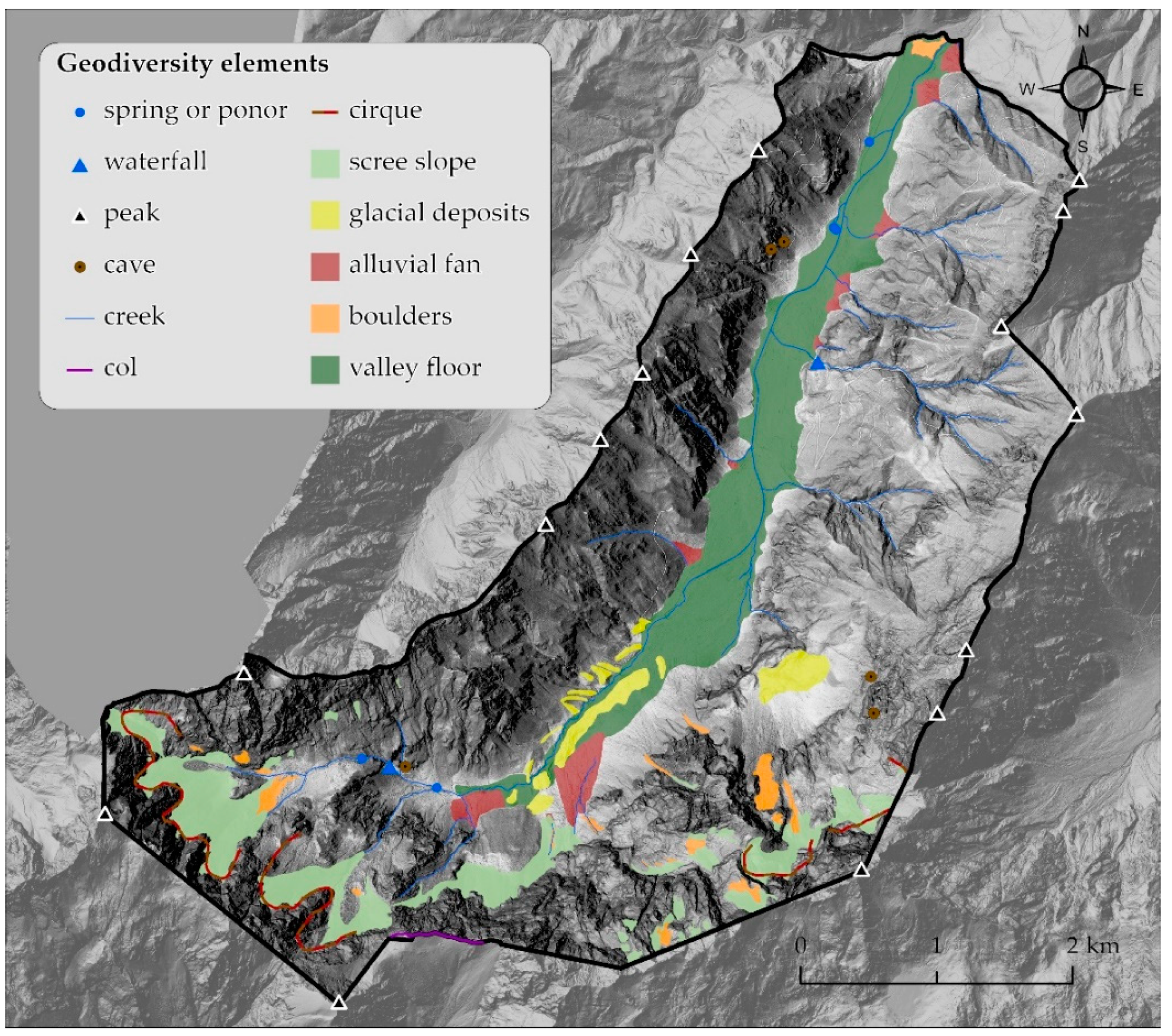
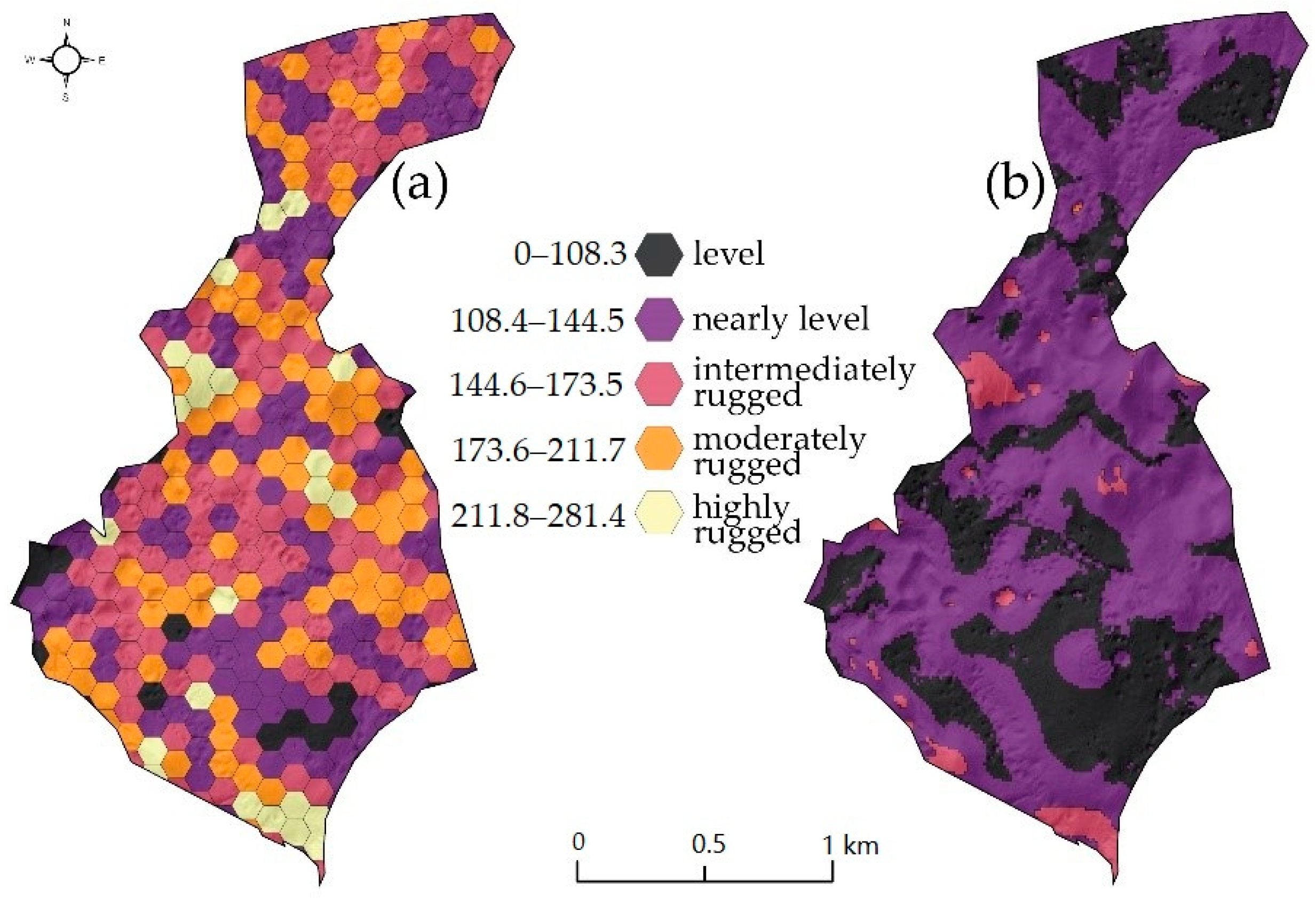

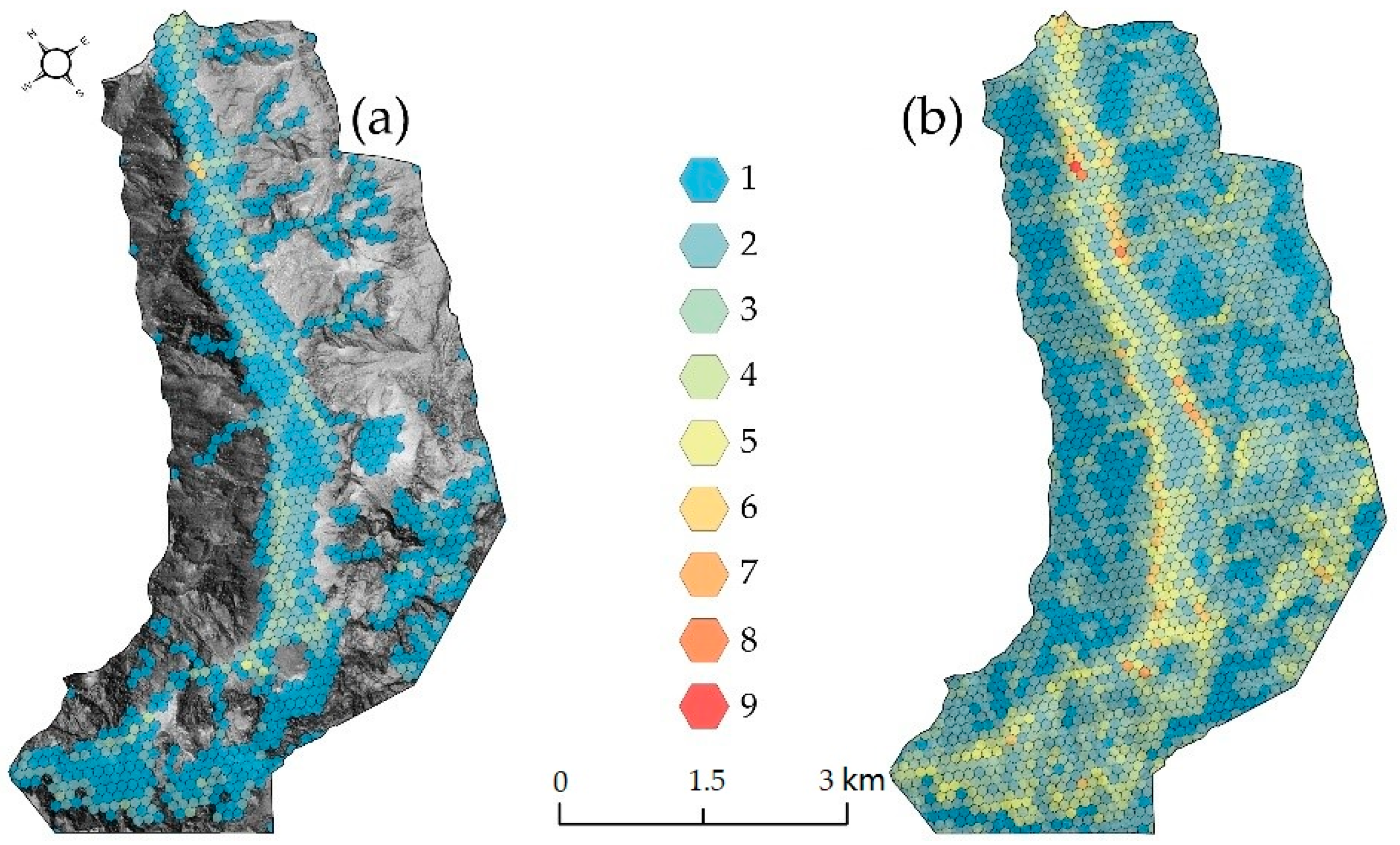

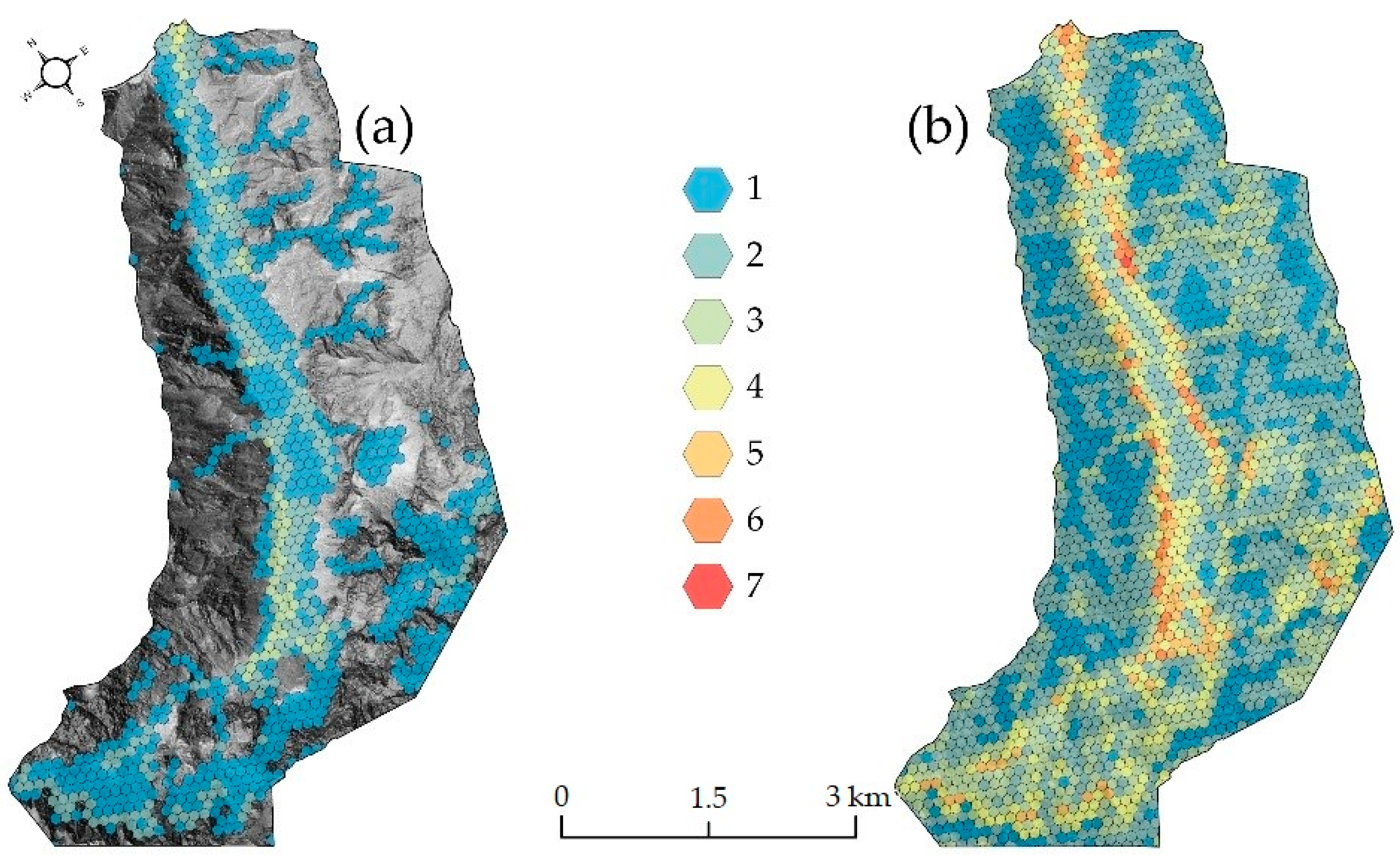
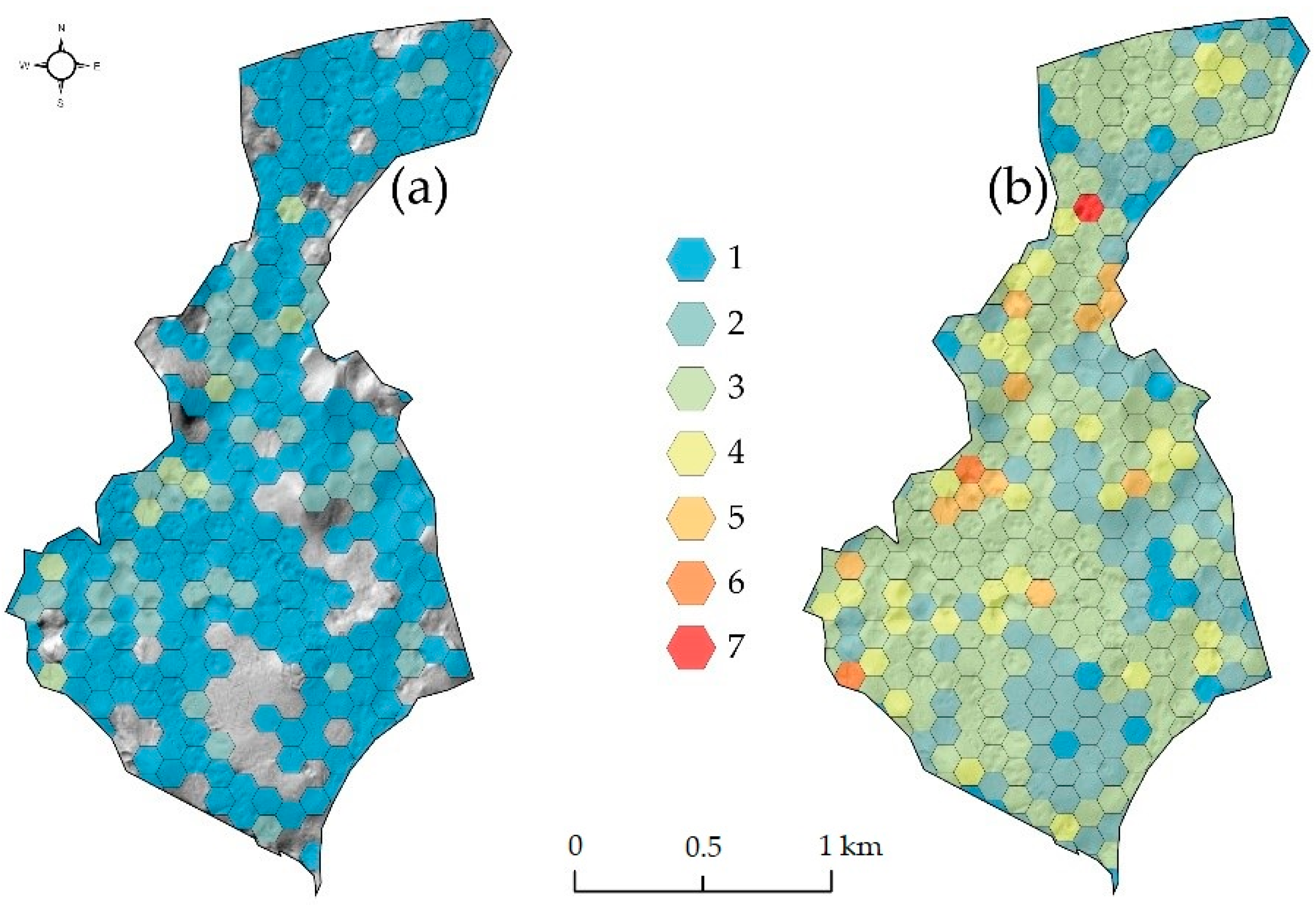
| Block | Maximum Value | Minimum Value | Difference | R | Eg | G |
|---|---|---|---|---|---|---|
| A | 100 | 0 | 100 | 100 | 2 | 200 |
| B | 500 | 400 | 100 | 300 | 2 | 600 |
| C | 1000 | 900 | 100 | 45,389 | 2 | 87,178 |
| Level | Region X | Region Y | Region W | Region Q | R for n Surface |
|---|---|---|---|---|---|
| Level A |   |   | For a specific region | ||
| Level B |  |   |   |   | For regions X and Y, Y and W, and W and G |
| Level C |  |   |   |  | For regions X, Y and W, and Y, W and Q |
| Level D |  |  |  |  | For all four regions |
Publisher’s Note: MDPI stays neutral with regard to jurisdictional claims in published maps and institutional affiliations. |
© 2022 by the author. Licensee MDPI, Basel, Switzerland. This article is an open access article distributed under the terms and conditions of the Creative Commons Attribution (CC BY) license (https://creativecommons.org/licenses/by/4.0/).
Share and Cite
Stojilković, B. Towards Transferable Use of Terrain Ruggedness Component in the Geodiversity Index. Resources 2022, 11, 22. https://doi.org/10.3390/resources11020022
Stojilković B. Towards Transferable Use of Terrain Ruggedness Component in the Geodiversity Index. Resources. 2022; 11(2):22. https://doi.org/10.3390/resources11020022
Chicago/Turabian StyleStojilković, Borut. 2022. "Towards Transferable Use of Terrain Ruggedness Component in the Geodiversity Index" Resources 11, no. 2: 22. https://doi.org/10.3390/resources11020022
APA StyleStojilković, B. (2022). Towards Transferable Use of Terrain Ruggedness Component in the Geodiversity Index. Resources, 11(2), 22. https://doi.org/10.3390/resources11020022






